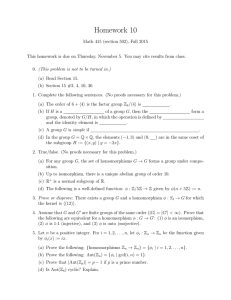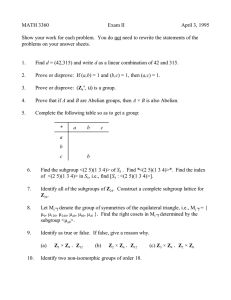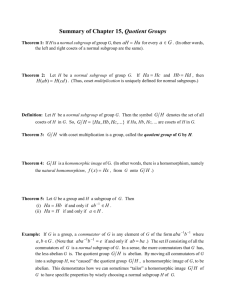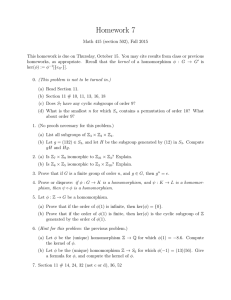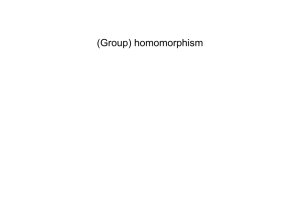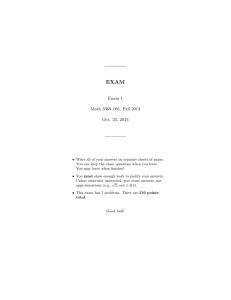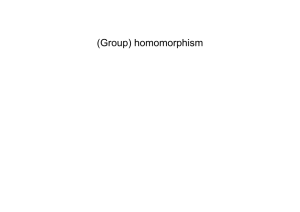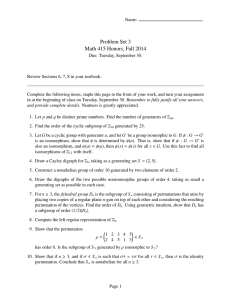Modern Algebra I 1 True/false
advertisement
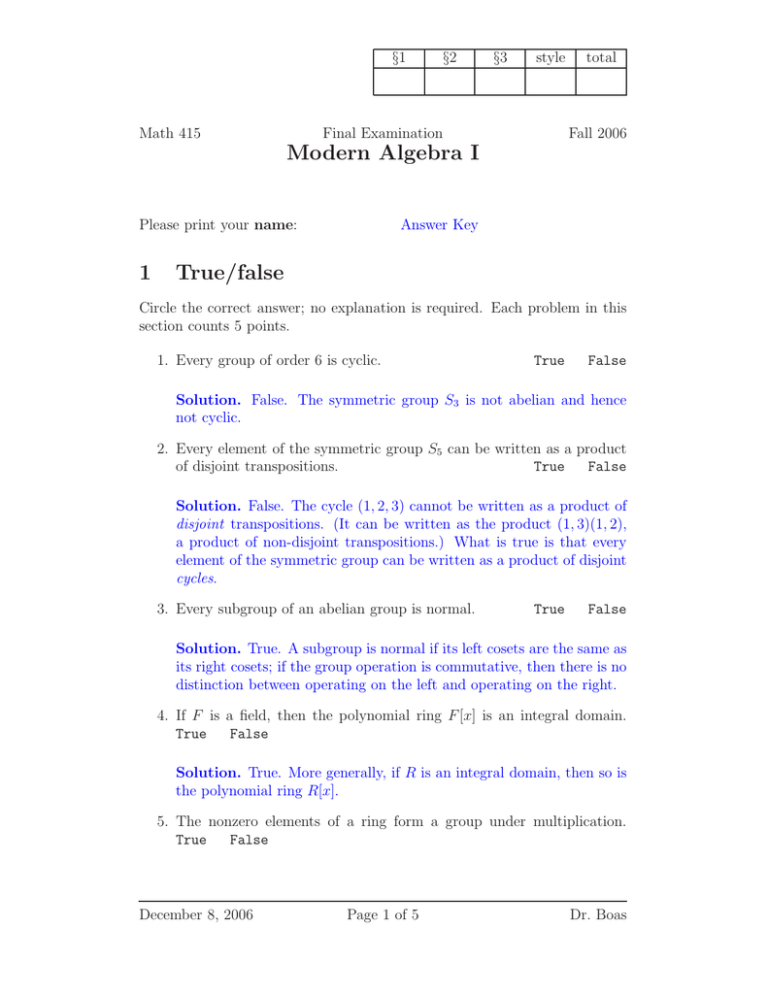
§1
Math 415
§2
§3
style
Final Examination
total
Fall 2006
Modern Algebra I
Please print your name:
1
Answer Key
True/false
Circle the correct answer; no explanation is required. Each problem in this
section counts 5 points.
1. Every group of order 6 is cyclic.
True
False
Solution. False. The symmetric group S3 is not abelian and hence
not cyclic.
2. Every element of the symmetric group S5 can be written as a product
of disjoint transpositions.
True
False
Solution. False. The cycle (1, 2, 3) cannot be written as a product of
disjoint transpositions. (It can be written as the product (1, 3)(1, 2),
a product of non-disjoint transpositions.) What is true is that every
element of the symmetric group can be written as a product of disjoint
cycles.
3. Every subgroup of an abelian group is normal.
True
False
Solution. True. A subgroup is normal if its left cosets are the same as
its right cosets; if the group operation is commutative, then there is no
distinction between operating on the left and operating on the right.
4. If F is a field, then the polynomial ring F [x] is an integral domain.
True
False
Solution. True. More generally, if R is an integral domain, then so is
the polynomial ring R[x].
5. The nonzero elements of a ring form a group under multiplication.
True
False
December 8, 2006
Page 1 of 5
Dr. Boas
Math 415
Final Examination
Fall 2006
Modern Algebra I
Solution. False. The nonzero elements of a ring need not have multiplicative inverses (example: Z), there need not be a multiplicative
identity element (example: 2Z), and the set of nonzero elements need
not be closed under multiplication (example: Z6 , where (2)(3) = 0).
2
Short answer
Fill in the blanks; no explanation is required. Each problem in this section
counts 5 points.
6. The order of the element (2, 3) in the group Z6 × Z8 equals
.
Solution. The order of the element 2 in Z6 equals 3, the order of the
element 3 in Z8 equals 8, and the order of the element (2, 3) in Z6 × Z8
equals lcm(3, 8) or 24.
7. The permutation (1, 2)(3, 4, 5, 6) generates a cyclic subgroup H of the
symmetric group S6 . How many cosets does the subgroup H have?
Solution. The given permutation generates a cyclic subgroup H of
order 4. The cosets of H all have the same number of elements, and
they partition the group S6 . Therefore the number of cosets is 6!/4 or
180.
8. How many abelian groups of order 36 exist (up to isomorphism)? (Use
the fundamental theorem of finite abelian groups.)
Solution. Since 36 = 22 × 32 , the possible groups (up to isomorphism)
are Z4 × Z9 , Z2 × Z2 × Z9 , Z4 × Z3 × Z3 , and Z2 × Z2 × Z3 × Z3 . Thus
there are 4 such groups.
9. How many group homomorphisms φ : Z6 → Z4 exist?
(Don’t forget to count the 0 homomorphism.)
Solution. The are 2 such homomorphisms. One way to see this is the
following.
December 8, 2006
Page 2 of 5
Dr. Boas
Math 415
Final Examination
Fall 2006
Modern Algebra I
Observe that φ(4) = φ(1+1+1+1) = φ(1)+φ(1)+φ(1)+φ(1) = 0, since
every element of Z4 added to itself 4 times produces 0 in Z4 . Therefore
the kernel of φ contains the element 4 and hence the subgroup of Z6
generated by 4: namely, {0, 2, 4}, or h2i in different notation.
There does exist a homomorphism φ from Z6 into Z4 with this kernel:
namely, the composition of the coset mapping Z6 → Z6 /h2i ' Z2
with the isomorphism from Z2 onto the subgroup {0, 2} of Z4 . This
φ maps the elements 0, 2, and 4 of Z6 to the element 0 of Z4 and
maps the elements 1, 3, and 5 of Z6 to the element 2 of Z4 . By the
fundamental homomorphism theorem (page 140 in the textbook), every
homomorphism from Z6 into Z4 with kernel h2i factors through Z6 /h2i,
and since Z4 has a unique subgroup of order 2, there is only one such
homomorphism.
If the kernel of φ contains additional elements, then the kernel has to be
all of Z6 (since the kernel is a subgroup, and by Lagrange’s theorem the
order of the kernel has to divide 6). In this case, φ is the homomorphism
that sends every element to 0.
One can also solve the problem from first principles by looking at the
image of the generator 1 (which uniquely determines φ) and showing
that the homomorphism property forces φ(1) to be either 0 or 2.
10. When 35000 is divided by 17 the remainder equals
.
Solution. Since 17 is a prime number, Fermat’s theorem implies that
316 ≡ 1 mod 17. Now 5000 = (312 × 16) + 8, so 35000 ≡ 38 mod 17.
Finally observe that 38 = 812 ≡ (−4)2 ≡ 16 mod 17. Thus the remainder equals 16.
3
Essay questions
In the following problems, you must give an explanation. (Continue on the
back if you need more space.) Each problem counts 15 points. In addition,
this section as a whole carries 5 style points based on how well your solutions
are written.
December 8, 2006
Page 3 of 5
Dr. Boas
Math 415
Final Examination
Fall 2006
Modern Algebra I
11. Give an example of a group G that has a pair of subgroups H and K
with the property that the union H ∪ K is not a subgroup. Explain
why your example works.
Solution. What can go wrong is that the union H ∪ K may not be
closed under the group operation.
There are many examples. Here is a popular one: G = Z6 , H =
{0, 2, 4}, K = {0, 3}. Then H and K are subgroups of G, but the
union {0, 2, 3, 4} is not a subgroup, because it contains the elements 2
and 3 but not the sum 2 + 3.
12. Suppose G is a simple group (recall this means that G has no proper,
nontrivial, normal subgroup), and φ : G → G0 is a homomorphism onto
a nontrivial group G0 . Show that φ is an isomorphism.
Solution. An isomorphism is a homomorphism that is both one-to-one
and onto. It is given that the homomorphism φ is onto, so what needs
to be shown is that φ is one-to-one. In other words, we need to show
that the kernel of φ is trivial.
Now the kernel of φ is a normal subgroup of G; since G is simple,
Ker(φ) must be either trivial or all of G. In the second case, φ would
send every element of G to the identity element of G0 , so φ would not
map onto the nontrivial group G0 , contrary to hypothesis. Thus the
only possibility is that the kernel of φ is the trivial subgroup of G, and
so φ is one-to-one.
13. Show that the polynomial x3 + 4x2 + 4x + 2 is irreducible over Q but
factors into linear factors over the field Z11 .
Solution. The prime number 2 divides each of the coefficients except
the leading coefficient, and 22 does not divide the constant coefficient.
Therefore Eisenstein’s criterion applies and shows that the polynomial
is irreducible over Q.
Alternatively, observe that since the polynomial has degree 3, it factors
only if it has at least one factor of degree 1, or equivalently if it has
at least one zero. The only candidates for zeroes in Q are ±1 and ±2.
December 8, 2006
Page 4 of 5
Dr. Boas
Math 415
Final Examination
Fall 2006
Modern Algebra I
One easily checks that none of the candidates actually is a zero, so the
polynomial is irreducible over Q.
By inspection, 1 is a zero of the polynomial in the field Z11 , since
1 + 4 + 4 + 2 = 11. Therefore (x − 1), or equivalently (x + 10), is a
factor of the polynomial over this field. Long division in Z11 [x] shows
that x3 + 4x2 + 4x + 2 = (x + 10)(x2 + 5x + 9) in Z11 [x]. Now 5 is the
same as −6 (mod 11), and x2 − 6x + 9 = (x − 3)2 , so x3 + 4x2 + 4x + 2
factors over Z11 as (x + 10)(x + 8)2 .
December 8, 2006
Page 5 of 5
Dr. Boas
